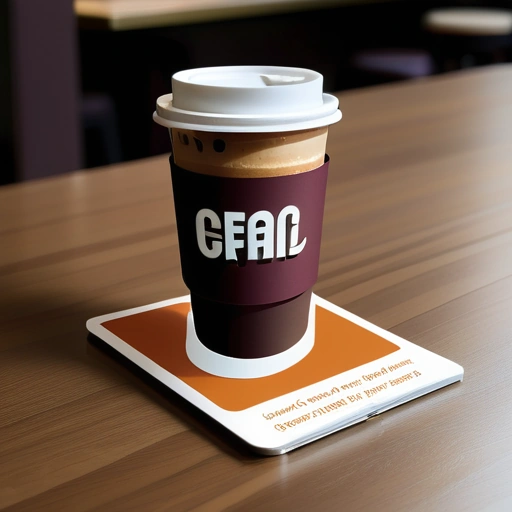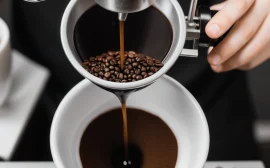The Cool Wave: Japanese Iced Coffee Takes Hold
In the ever-evolving landscape of specialty coffee, a new chill has taken hold. Japanese-style iced coffee, specifically the flash-brewing method, is rapidly gaining traction in premium cafes worldwide. More than just a refreshing beverage, it represents a commitment to quality, precision, and a nuanced flavor profile that is resonating with discerning coffee drinkers. This meticulous approach to iced coffee aligns perfectly with the third wave coffee movement’s emphasis on elevating the entire coffee experience, from bean to cup.
Cafes are discovering that offering a superior iced coffee option, like flash brew, can significantly impact cafe profit margin by attracting customers willing to pay a premium. Flash brew’s appeal extends beyond mere refreshment; it’s about delivering an exceptional sensory experience. Unlike traditional methods that often result in diluted or bitter iced coffee, flash brewing preserves the delicate nuances of the coffee’s origin and roast. The rapid chilling process locks in the volatile aromatic compounds, resulting in a brighter, cleaner, and more complex cup.
For instance, a single-origin Ethiopian Yirgacheffe, known for its floral and citrus notes, will retain those characteristics beautifully when flash brewed, offering a stark contrast to the often-muddled flavors of conventionally prepared iced coffee. The adoption of Japanese iced coffee also reflects a broader trend within the cafe business: the pursuit of differentiation. In a competitive market, offering unique and high-quality beverages is crucial for attracting and retaining customers. Investing in specialized iced coffee equipment, such as precise drippers and aesthetically pleasing ice towers, signals a commitment to quality that resonates with coffee aficionados. Moreover, mastering the flash brew technique requires skilled baristas who understand the nuances of extraction and temperature control, further enhancing the cafe’s reputation for expertise. As cafes seek innovative ways to enhance their offerings, Japanese iced coffee presents a compelling opportunity to elevate the iced coffee experience and distinguish themselves within the thriving third wave coffee scene.
The Science of Superior Flavor: Why Flash Brew?
The allure of Japanese iced coffee lies in its ability to deliver a clean, bright, and intensely flavorful cup, a hallmark of third wave coffee’s dedication to quality. Unlike traditional iced coffee, which is often brewed hot and then cooled, often resulting in diluted flavors, or cold brewed over an extended period, potentially extracting unwanted bitterness, flash brewing involves brewing hot coffee directly over ice. This rapid cooling process locks in delicate aromatics and prevents the oxidation that can lead to a bitter or muddy taste.
The speed of chilling is critical; it preserves volatile compounds that would otherwise degrade, translating to a brighter, more nuanced cup. This meticulous approach resonates with consumers seeking premium coffee experiences. Consumers are increasingly aware of these differences, driving a willingness to pay a premium, which directly impacts cafe profit margin. The flash brew method, with its emphasis on precision and flavor clarity, aligns perfectly with the values of the third wave coffee movement. Cafes are leveraging this perception of superior quality to differentiate themselves in a competitive market.
The visual appeal of the brewing process, often involving carefully measured ice and a slow, deliberate pour, further enhances the customer experience. This ritualistic element transforms a simple iced coffee into a sophisticated offering, justifying the higher price point. Furthermore, the perceived value extends beyond just taste. The use of specialized iced coffee equipment, such as Hario V60 drippers or sophisticated ice towers, signals a commitment to quality and craftsmanship. This investment in equipment, while contributing to startup costs, ultimately reinforces the cafe’s dedication to providing an exceptional product. From a cafe business perspective, offering Japanese iced coffee allows for premium pricing strategies and attracts a clientele that values quality over cost. This aligns with the broader trend of consumers seeking elevated experiences and supports a sustainable business model focused on quality and craftsmanship, rather than simply volume.
Equipment and Techniques: Mastering the Flash Brew
Implementing Japanese iced coffee requires specific equipment and a refined understanding of brewing parameters, making it a hallmark of third wave coffee establishments. Specialized drippers, such as the Hario V60 or Kalita Wave, are commonly used to control the flow rate and ensure even saturation of the coffee grounds, critical for optimal extraction. Ice towers, while not essential, add a visual element appealing to customers seeking a premium coffee experience and allow for a slower, more controlled dilution, further refining the final flavor profile.
These tools, while relatively inexpensive, signal a cafe’s commitment to quality and precision. Optimal water temperature is crucial, typically ranging from 200-205°F (93-96°C), to ensure proper extraction without over-extraction, preventing bitterness or a weak, underdeveloped taste. The ratio of coffee to water to ice is also critical, usually around 1:15 for coffee to total liquid (water + melted ice), but this can be adjusted based on the bean’s characteristics and desired strength. Water quality plays a vital role; filtered water is a must to eliminate impurities that can negatively impact the delicate flavors of the coffee.
The grind size should be medium-fine, similar to that used for pour-over coffee, allowing for proper extraction without clogging the dripper. Beyond the basic equipment, mastering the flash brew method requires a deep understanding of how each variable impacts the final cup. For example, experimenting with different ice types – large cubes versus crushed ice – can alter the dilution rate and texture of the Japanese iced coffee. Furthermore, pre-chilling the serving glass can help maintain the coffee’s temperature and prevent rapid dilution, preserving the intended flavor profile.
This attention to detail is what separates truly exceptional Japanese iced coffee from merely adequate versions and directly influences customer perception of quality. From a cafe business perspective, offering Japanese iced coffee can contribute to a higher perceived value and potentially increase cafe profit margin. While the cost of iced coffee equipment is relatively low, the perceived craftsmanship and the use of premium coffee beans justify a higher price point compared to traditional iced coffee. Moreover, the visual appeal of the brewing process, especially with an ice tower, can attract customers and create a unique selling proposition. Effectively marketing the quality and precision of the flash brew method is key to maximizing its impact on revenue and solidifying a cafe’s reputation within the third wave coffee movement.
Implementing Japanese Iced Coffee: A Practical Guide for Cafes
For cafes considering adding Japanese iced coffee to their menu, a careful assessment of startup costs, operational considerations, and staff training needs is essential. Startup costs include the purchase of specialized drippers (approximately $20-$50 each), ice towers (optional, ranging from $100-$500), and potentially a high-quality water filtration system. Operational considerations include increased ice consumption and the need for dedicated barista training. Staff training should focus on proper brewing techniques, temperature control, and understanding the impact of different variables on the final flavor.
A profit margin analysis comparing Japanese iced coffee to traditional iced coffee methods reveals a potential for increased revenue. While the cost of ingredients (coffee and ice) may be slightly higher, the ability to charge a premium price, typically $1-$2 more per cup, can significantly boost profitability. For example: Traditional Iced Coffee (Cost: $1.50, Sale Price: $4.00, Profit: $2.50). Japanese Iced Coffee (Cost: $2.00, Sale Price: $5.50, Profit: $3.50). This represents a 40% increase in profit per cup.
However, cafes must also factor in the cost of labor and the time required to prepare each drink. Beyond the initial investment, cafes should meticulously analyze their existing workflow to seamlessly integrate the flash brew method. Consider dedicating a specific station for Japanese iced coffee preparation, particularly during peak hours, to avoid bottlenecks. This station should be equipped with all necessary iced coffee equipment, including pre-weighed coffee doses, calibrated scales, and readily available ice. Furthermore, baristas need to be proficient in dialing in the grind size and adjusting brewing parameters to achieve optimal extraction and flavor.
This requires ongoing training and quality control measures to ensure consistency in every cup. The integration of Japanese iced coffee aligns perfectly with the third wave coffee movement’s emphasis on precision and quality, enhancing the cafe’s reputation and attracting discerning customers. From a cafe business perspective, introducing Japanese iced coffee can be a strategic move to differentiate from competitors and capture a larger share of the premium coffee market. The perceived value of flash brew, coupled with its superior flavor profile, justifies the higher price point and contributes to increased cafe profit margin.
Marketing efforts should highlight the unique aspects of the brewing method, emphasizing the commitment to quality and the resulting exceptional taste. Visual cues, such as showcasing the brewing process with an ice tower, can further enhance the customer experience and create a sense of theater. By effectively communicating the value proposition of Japanese iced coffee, cafes can cultivate customer loyalty and drive repeat business. Moreover, offering seasonal variations or coffee bean selections specifically tailored for flash brew can keep the menu fresh and exciting.
To further enhance the profitability of Japanese iced coffee, cafes can explore strategies to optimize ice usage and reduce waste. Investing in a high-quality ice machine that produces dense, slow-melting ice can minimize dilution and maintain the desired flavor profile. Implementing a system for tracking ice consumption and identifying areas for improvement can also contribute to cost savings. Additionally, cafes can consider offering Japanese iced coffee as part of a bundled deal or subscription service to incentivize purchases and generate recurring revenue. Ultimately, the success of implementing Japanese iced coffee hinges on a combination of factors, including meticulous brewing techniques, effective marketing strategies, and a commitment to delivering an exceptional customer experience. By carefully addressing these considerations, cafes can unlock the full potential of this increasingly popular brewing method and thrive in the competitive third wave coffee landscape.
The Future of Iced Coffee: A Chilling Conclusion
Japanese-style iced coffee, particularly the flash brew method, represents more than just a fleeting fad; it’s a bellwether of the evolving preferences within the third wave coffee movement. This brewing technique underscores a broader consumer demand for meticulously crafted, high-quality beverages, pushing cafes to elevate their standards. By embracing flash brew, establishments signal a commitment to both flavor and innovation, differentiating themselves in a saturated market. This dedication can translate directly into increased customer loyalty and a willingness to pay a premium for a superior iced coffee experience.
For instance, cafes specializing in single-origin beans often find that flash brew allows them to showcase the nuanced profiles of their offerings, something often masked in traditional iced coffee preparations, ultimately boosting their cafe profit margin. The initial investment in specialized iced coffee equipment and comprehensive staff training is undeniably a key consideration for any cafe owner. While the cost of drippers, ice towers (for visual appeal and chilling), and potentially a more robust water filtration system can seem substantial, viewing these expenses as strategic investments is crucial.
Furthermore, barista training should extend beyond the basic brewing technique to encompass an understanding of how grind size, water temperature, and bloom time affect the final flavor profile. Cafes that invest in this knowledge base empower their staff to consistently produce exceptional Japanese iced coffee, ensuring customer satisfaction and repeat business. Consider, for example, a cafe that invested in training its baristas on adjusting the flash brew recipe based on the specific coffee bean’s characteristics; this led to a 20% increase in iced coffee sales within a month, demonstrating the tangible return on investment.
Moreover, the appeal of Japanese iced coffee extends beyond its superior taste; it also taps into the growing consumer interest in transparency and the art of coffee preparation. The visual spectacle of the flash brew method, often performed meticulously in front of customers, adds an element of theater and enhances the overall cafe experience. This creates a sense of connection and appreciation for the craft involved, fostering customer engagement and loyalty. Cafes can further capitalize on this by offering educational workshops or brewing demonstrations, showcasing the intricacies of the flash brew process and further solidifying their position as purveyors of premium coffee.
By positioning Japanese iced coffee as more than just a beverage but as an experience, cafes can command higher prices and cultivate a dedicated following. Looking ahead, the future of iced coffee in the specialty coffee sector is inextricably linked to innovation and quality. As consumers become increasingly discerning, the demand for meticulously crafted beverages like Japanese iced coffee will only continue to grow. Cafes that proactively embrace these trends, investing in the necessary equipment, training, and marketing efforts, will be well-positioned to thrive in an increasingly competitive market. The cool wave of flash brew is not just a trend; it’s a reflection of a fundamental shift in consumer preferences, and those who adapt will undoubtedly reap the rewards, solidifying their place in the ever-evolving landscape of third wave coffee.



